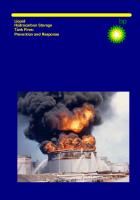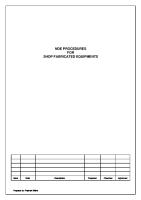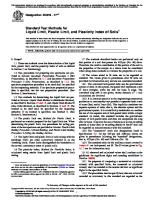AFB Liquid Palatants [PDF]
STORAGE AND STABILITY OF LIQUID PALATANTS GENERAL INFORMATION Liquid palatants are moderately viscous, low pH materials
37 0 214KB
Papiere empfehlen
![AFB Liquid Palatants [PDF]](https://vdoc.tips/img/200x200/afb-liquid-palatants.jpg)
- Author / Uploaded
- Andrei Bogdan
Datei wird geladen, bitte warten...
Zitiervorschau
STORAGE AND STABILITY OF LIQUID PALATANTS
GENERAL INFORMATION Liquid palatants are moderately viscous, low pH materials requiring specific storage and handling considerations. Product-contact surfaces should be constructed of 316 or 304 stainless steel, fiberglass or plastic. Carbon, steel and brass should be avoided. Liquid palatants should be well mixed prior to use to ensure optimal performance. Below is additional information on common delivery methods and stability information for AFB International palatants.
BULK Bulk shipments are typically 5,500 gallons or 20,000 liters and will arrive at 85-105°F/25-30°C. These shipments may be offloaded with an onboard pump or dedicated unloading pump. Bulk storage tanks should have a capacity of 8,000-10,000 gallons in North America and about 30,000 liters in Europe. They should be equipped with a high efficiency agitation system that minimizes air incorporation to prevent foaming and oxidation. Storage tanks should include provisions to maintain temperatures 85-120°F/25-35°C (depending on the product) to control viscosity. AFB is pleased to assist in evaluating designs of temperature control systems if needed. Liquid palatant shelf life is typically between six and 12 months. Storage recommendations for individual products can be found on the product information sheet. For optimal palatability performance, storage time for liquid palatability enhancers should be minimized. Periodically (at least annually), bulk tanks should be completely voided, cleaned, and sanitized. A common cleaning procedure is a hot water rinse, followed by foaming with an alkaline-based solution, and rinsed with a no-rinse food grade sanitizer.
INTERMEDIATE BULK CONTAINER (IBC) An intermediate bulk container, or IBC, holds approximately 2,500 pounds of liquid in North America and 1,000 kilograms in Europe. This container is also sometimes called a tote. In North America, the IBC is a square corrugated shell surrounding a polypropylene bag covered with a corrugated top. The bag is treated with an antimicrobial agent to prevent mold growth at the product bag interface. In Europe, the IBC is a high density polyethylene container with UV protection that is surrounded by a galvanized steel cage. The IBC may be stacked two high and should be stored in an area above 70°F/20-25°C. Prior to use, the IBC should be well mixed to ensure optimal performance. The most common mixing method is recirculation.
DRUM A standard drum contains 55 gallons or 200 liters. In North America, the drum has a polypropylene liner. The liner is tied closed at the top to prevent air from entering the liner. The gathered liner is treated with an antimicrobial agent to prevent mold growth at the product liner interface. If a partially used drum needs to be stored, be sure that the liner is drawn down, re-sprayed, and then re-tied to reduce air exposure. Prior to use, liquid products stored in drums should be mixed well to ensure homogeneity. In cases where a drum product is moved to an intermediate tank prior to use, adequate mixing may be achieved at this point. If it becomes necessary to dispose of expired product, suggestions for disposal can be found on the product’s safety data sheet or by contacting the AFB Customer Service team.
STABILITY Liquid palatants are stabilized using different methods to ensure optimal performance during product shelf life. Proper product handling is an important part of ensuring this performance.
MICROBIOLOGICAL STABILITY AFB liquid palatants are microbiologically preserved using potassium sorbate as the primary anti-mycotic, in combination with an approved acidulant. These products will not support the growth of common food spoilage organisms. The integrity of the preservation system must not be compromised or microbiological growth is possible. Liquid products in IBCs and drums are best stored by minimizing air contact thereby discouraging growth of aerobic organisms like molds. Where used, drum liners should be collapsed and re-tied after use.
CHEMICAL STABILITY Fat present in liquid products is chemically stabilized using antioxidants such as mixed tocopherols. Antioxidants are introduced as early as possible in the manufacturing process to ensure that fat oxidation is controlled throughout the process. Excessive agitation and air incorporation into liquid products may compromise the integrity of the antioxidant system. Dilution or adulteration of liquid palatant products may destabilize the preservation systems being employed. These practices should be avoided. Contact the AFB Customer Service team for assistance should this occur.
To discover all the ways the Palatability Performance People at AFB International can help you improve product performance and market share, visit our blog at www.palatantsplus.com, our website at www.afbinternational.com or contact us directly:
North America 800 218 5607 [email protected]
Latin America 54 11 4894 8570 [email protected]
Europe 31 88 82 30 000 [email protected]
Asia Pacific 61 3 9879 9093 [email protected]







